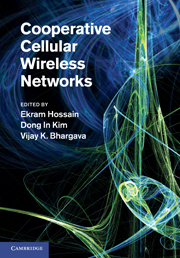Book contents
- Frontmatter
- Contents
- List of contributors
- Preface
- Part I Introduction
- Part II Cooperative base station techniques
- Part III Relay-based cooperative cellular wireless networks
- 6 Distributed space-time block codes
- 7 Collaborative relaying in downlink cellular systems
- 8 Radio resource optimization in cooperative cellular wireless networks
- 9 Adaptive resource allocation in cooperative cellular networks
- 10 Cross-layer scheduling design for cooperative wireless two-way relay networks
- 11 Green communications in cellular networks with fixed relay nodes
- 12 Network coding in relay-based networks
- Part IV Game theoretic models for cooperative cellular wireless networks
- Part V Standardization activities
- Index
6 - Distributed space-time block codes
from Part III - Relay-based cooperative cellular wireless networks
Published online by Cambridge University Press: 03 May 2011
- Frontmatter
- Contents
- List of contributors
- Preface
- Part I Introduction
- Part II Cooperative base station techniques
- Part III Relay-based cooperative cellular wireless networks
- 6 Distributed space-time block codes
- 7 Collaborative relaying in downlink cellular systems
- 8 Radio resource optimization in cooperative cellular wireless networks
- 9 Adaptive resource allocation in cooperative cellular networks
- 10 Cross-layer scheduling design for cooperative wireless two-way relay networks
- 11 Green communications in cellular networks with fixed relay nodes
- 12 Network coding in relay-based networks
- Part IV Game theoretic models for cooperative cellular wireless networks
- Part V Standardization activities
- Index
Summary
Introduction
In this chapter, we consider space-time coding strategies for multiple-relay cooperative systems that effectively harness available spatial diversity. More specifically, the goal is to examine ways to forward signals efficiently from multiple relays to the destination while addressing the important practical issue of synchronization among the relays. We assume a general two-phase transmission protocol as illustrated in Figure 6.1. In the first phase of the protocol, the source broadcasts a message which is received by the relays and (possibly) the destination. During the second transmission phase, a subset of the relays, possibly in conjunction with the source, transmits additional information to the destination. This protocol is useful in practical scenarios where signals received at the destination due to transmissions directly from the source (Phase 1) will not carry enough useful information because of noise, fading, and/or interference.
It is expected that Phase 2 will dramatically increase the reliability of the system, but if the symbols cannot be decoded correctly after the second phase, the protocol can restart by returning to Phase 1 or Phase 2.
The primary problem associated with forwarding information from multiple relays to the destination is determining how the information should be spread out among the relays over space and time. This is analogous to the classic spacetime coding problem in point-to-point multiple-transmit-antenna systems, and so it is often called the distributed space-time coding problem.
- Type
- Chapter
- Information
- Cooperative Cellular Wireless Networks , pp. 153 - 175Publisher: Cambridge University PressPrint publication year: 2011
- 1
- Cited by



